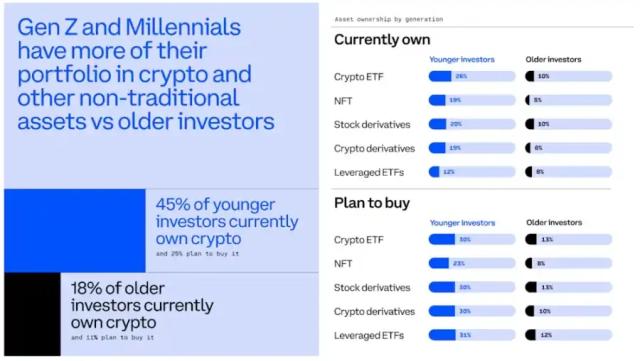First, a bull market is usually accompanied by a broad market rise, especially a surge in the prices of mainstream cryptocurrencies such as Bitcoin and Ethereum. This price volatility often attracts a large number of investors into the market. However, many may find that despite the overall positive market trend, their investment returns are far lower than expected.
One of the reasons behind this is that while the market is generally in an upward cycle, the performance of different assets varies greatly. In some cases, investors may have purchased small cryptocurrencies or high-risk projects that did not deliver the expected returns, or even missed the mainstream trends in the market. The choice of such investment strategies may make it difficult to obtain the expected gains in a bull market, leading to a sense of disappointment and resentment unrelated to the bull market.
Changes in market structure and adjustment of investor sentiment
The bull market in the crypto industry in 2024 is not entirely a "broad market rise" in the traditional sense. With the rise of new areas such as DeFi, Non-Fungible Tokens (NFTs), and Layer2 solutions, investors' funds often flow to relatively smaller or emerging market segments. These areas have greater volatility, and their performance is often not as stable and rapid as mainstream cryptocurrencies due to factors such as technological development and market acceptance.
In this case, some investors may have failed to keep up with the changes in the market, still investing in outdated or overly centralized platform projects, missing the opportunities in the more promising emerging areas. Therefore, even though they are in a bull market, investors who fail to adapt to market changes cannot feel the expected returns, leading to a sense of dissatisfaction "unrelated to the bull market".
The psychological burden of "high leverage" and "high risk"
For some investors seeking high returns, they may choose to increase their investment scale through leveraged trading in the hope of achieving higher returns. However, high leverage not only amplifies potential gains but also amplifies risks. In the case of large market price fluctuations, many investors may suffer losses or be forced to liquidate due to improper operation or short-term market volatility.
In a bull market environment, due to the frequent and severe price fluctuations, some highly leveraged investors often experience significant psychological burdens in the short term. This "painful when winning, more painful when losing" state makes them feel dissatisfied with the market, even if they are in a bull market.
Delayed investment decisions and emotion-driven
In a rapidly developing market, investors often face difficult choices. In the early stages of a bull market, many investors may have failed to enter the market in a timely manner, missing the best investment opportunities. As the market gradually rises, many investors begin to "chase the trend," trying to buy at the high points. However, the market does not always develop as expected, and some "buy high, sell low" investors suffer losses during the market's short-term corrections.
This emotion-driven investment decision-making often leads to poor timing choices and irrational capital flows, further exacerbating the feeling of being disconnected from the bull market. Even if the overall market is in a bull market, the mentality and investment strategies of some investors may cause them to always be "buying at the highest price" and miss out on the real profit growth.
Information asymmetry and market noise
In the crypto industry in 2024, the speed and quality of information flow are key factors. Although the market is generally in a bull market, investors are often disrupted by a large amount of market noise and false information. Whether it's media hype, "insider information" on social platforms, or "panic sentiment," these can lead investors to make irrational decisions.
Information asymmetry means that many investors are unable to obtain correct market judgments, and thus fall into misconceptions even in a bull market. Some may even choose to withdraw or adjust their investments due to excessive concerns about the bursting of the market bubble, missing out on subsequent profit opportunities. This decision-making lag caused by misinformation further exacerbates the disconnect from the bull market.
Excessive market optimism and rational investment
Market sentiment in a bull market often tends to be extremely optimistic, with investors generally confident in the market, leading many to have overly high return expectations. However, excessive optimism can sometimes overlook potential market risks, leading to excessive speculation on certain projects and cryptocurrencies.
Rational investment requires balancing risk and return, avoiding blind following and emotional decision-making. Maintaining rationality, diversifying investments, and setting reasonable profit-taking and stop-loss points in a bull market can help avoid the "bull market is unrelated to me" mentality and ensure stable returns as the market rises.
The "resentful bull market" in 2024 reflects that even in an environment of widespread market uptrend, there are still many investors who miss opportunities, lose control of their emotions, and have delayed decision-making. They may be disconnected from the market growth due to their inability to adapt to market changes in a timely manner, over-reliance on leverage, information flow constraints, or emotional investment.
To achieve stable returns in a bull market, investors need to rationally analyze market dynamics, avoid blind following, maintain proper risk management, and constantly pay attention to the changes in emerging areas and technologies. After all, while a bull market offers many opportunities, whether one can seize the opportunities and achieve the desired returns ultimately depends on the decision-making wisdom and market insight of each investor.







